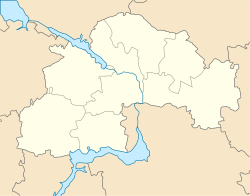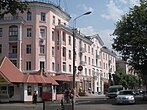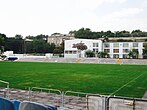Kamianske
 From Wikipedia - Reading time: 11 min
From Wikipedia - Reading time: 11 min
Kamianske
Кам'янське | |
|---|---|
| Coordinates: 48°31′0″N 34°36′48″E / 48.51667°N 34.61333°E | |
| Country | |
| Oblast | Dnipropetrovsk Oblast |
| Raion | Kamianske Raion |
| Hromada | Kamianske urban hromada |
| First mentioned | 1750 |
| Government | |
| • Mayor | Andriy Bilousov |
| Area | |
• City | 138 km2 (53 sq mi) |
| Elevation | 120 m (390 ft) |
| Population (2022)[1] | |
• City | 226,845 |
| • Density | 1,600/km2 (4,300/sq mi) |
| • Metro | 238,832 |
| Postal code | 51900 |
| Area code | +380-5692 |
| Website | http://kam.gov.ua/ |
 | |
Kamianske (Ukrainian: Кам'янське, IPA: [kɐmjɐnʲˈsʲkɛ] ), previously known as Dniprodzerzhynsk from 1936 to 2016,[a] is an industrial city in Dnipropetrovsk Oblast, Ukraine, and a port on the Dnieper River. It serves as the administrative center of Kamianske Raion and Kamianske urban hromada.[2] Population: 226,845 (2022 estimate).[1]
On 19 May 2016, it was renamed back to its historical name of Kamianske.[3] Along with the city's name change, the city's hydroelectric station was renamed to Middle Dnieper Hydroelectric Power Plant.
Besides the hydroelectric station, the city houses a few other industrial enterprises: Prydniprovsky Chemical Plant (closed in 1991), Bahley Coke Factory and Dnieper Metallurgical Combine.
History
[edit]
The first written evidence of settlement in the territory of Kamianske appeared in 1750. At that time the villages of Romankove and Kamianske, which make up the modern city, formed a part of the Nova ("New") Sich of the Zaporozhian Cossacks. The city was known as Kamianske (Ukrainian: Кам'янське; Russian: Каменское, romanized: Kamenskoye, lit. 'Stony Place') until 1936,[4] when it was renamed Dniprodzerzhynsk – the name honored the Dnieper River and the Bolshevik leader Felix Dzerzhynsky (1877–1926), the founder of the Soviet secret police, the Cheka.
On 11 August 1979, two Aeroflot passenger jets, collided in mid-air near Dniprodzerzhynsk, killing all 178 people on both aircraft.
On 15 May 2015, the president of Ukraine, Petro Poroshenko, signed a bill into law that started a six-month period for the removal of communist monuments and the mandatory renaming of settlements with names related to communism.[5] The following year, on 19 May 2016, the Ukrainian Verkhovna Rada voted to rename Dniprodzerzhynsk, which reverted to using its historic name Kamianske.[6]
Until 18 July 2020, Kamianske was incorporated as a city of oblast significance and the center of Kamianske Municipality. The municipality was abolished in July 2020 as part of the administrative reform of Ukraine, which reduced the number of raions of Dnipropetrovsk Oblast to seven. The area of Kamianske Municipality was merged into newly established Kamianske Raion.[7][8]
During the Russian invasion of Ukraine, on 8 April 2022, almost 12,000 people from the surrounding areas were temporarily evacuated to the city due to active hostilities.[9] By 1 September, the number had increased to 35,000 people.[10]
Population
[edit]Ethnic groups
[edit]Distribution of the population by ethnicity according to the 2001 census:[11]
Language
[edit]Distribution of the population by native language according to the 2001 census:[12]
| Language | Percentage |
|---|---|
| Ukrainian | 64.85% |
| Russian | 34.47% |
| other/undecided | 0.68% |
Geography
[edit]While mostly located on right bank of Dnieper, Kamianske stretches over the hydroelectric station onto the left bank where the portion of city is known as "Livyi bereh" neighborhood (literally Left bank). The neighborhood arches to the west of the Kamianske's suburb of Kurylivka.
To the east Kamianske municipality borders Dnipro city creating an urban sprawl.
Kamianske is a city with a very difficult environmental conditions. The city is on the top 10 of the most air-polluted cities of Ukraine.[13] There have been suggestions to assign the status of the ecological disaster city. Right-bank part of the city is mostly polluted, where the metallurgical, chemical industrial enterprises are located.
In 2008, an interdepartmental commission for solving environmental problems was created.[14]
Climate
[edit]The climate is moderately continental, dry.[15] The amount of precipitation per year is about 400 mm. The average daily temperature is -6°C in January, + 21°C in July.[16]
Administrative divisions
[edit]Kamianske is divided into three urban districts.
- Dniprovskyi District (western city district)
- neighborhoods: Romankove (former settlement), Livyi bereh
- Zavodskyi District (central city district)
- neighborhoods: City center, Dnieper Metallurgical Combine
- Pivdennyi District (south and eastern city parts)[17][18]
- settlements: Karnaukhivka, Svitle
- neighborhoods: Sotsmisto, Pivdennyi, Bahliy Coke Factory, DniproAzot and Prydniprovskyi Chemical Factory
Economy
[edit]The economic base of Kamianske is almost exclusively centered on heavy industry, with ferrous metallurgy being the backbone of the local economy. Around 57% of the total industrial production is metallurgy and metal working. The chemical industry comes second with a 17% share of the total industrial output.[19] While the exceedingly industrialized nature of the local economy ensures a rather high employment rate (as of 1 November 2007, official unemployment stood at 1.40%),[20] it also contributes to excessive pollution and radiation levels in the city.[21]
- Prydniprovsky Chemical Plant (closed down)
- Bahley Coke Factory
- Dnieper Metallurgical Combine
- DniproAzot
- Dniprodzerzhynsk Cement Factory
- Dniprodzerzhynsk Electrical Central
- Middle Dnieper Hydroelectric Plant
Culture
[edit]Several Eastern Orthodox churches, the largest being the Orthodox Cathedral of Saint Nicholas, which dates from 1894,[22] serve the faithful of the city. By 2018, there were 22 parishes of Ukrainian Orthodox Church in Kamianske.[23]
The Roman Catholic Church of Saint Nicholas[24] built by the city's Polish community at the end of the nineteenth century, has become one of the centers of Roman Catholicism in Eastern Ukraine. The Catholic Parish of Saint Nicholas also includes a monastery run by the Order of Friars Minor Capuchin.[24]
The city has an active Jewish community with a large synagogue and a charity center.[25]
International relations
[edit]Twin towns — Sister cities
[edit]Kamianske is twinned with:
Gallery
[edit]-
Orthodox Church of Saint Nicholas
-
Roman Catholic Church of Saint Nicholas
-
"Beit Reuven" Synagogue and "Beit Baruch" Charitable Center
-
Theatre
-
City Hall
-
Downtown
-
Soviet-era apartment blocks
-
Museum
-
Metalurh Stadium
-
Monument Prometheus
-
Monument Taras Shevchenko
-
Train station
-
Tram in Kamianske
-
The bridge across the Dnieper
-
Hydroelectric power plant
-
Dniprovsky steel works (DMK)
Notable people
[edit]- Leonid Brezhnev (1906–1982), Soviet leader from 1964 to 1982
See also
[edit]Notes
[edit]References
[edit]- ^ a b Чисельність наявного населення України на 1 січня 2022 [Number of Present Population of Ukraine, as of January 1, 2022] (PDF) (in Ukrainian and English). Kyiv: State Statistics Service of Ukraine. Archived (PDF) from the original on 4 July 2022.
- ^ "Каменская городская громада" (in Russian). Портал об'єднаних громад України. Archived from the original on 7 May 2021. Retrieved 7 May 2021.
- ^ "Dniprodzerzhynsk renamed Kamianske". www.unian.info. Archived from the original on 29 December 2016. Retrieved 30 December 2018.
- ^ (in Ukrainian) Dniprodzerzhinsk and several more cities got new names. Ukrayinska Pravda. 19 May 2016
- ^ (in Ukrainian) Poroshenko signed the laws about decomunization Archived 23 April 2016 at the Wayback Machine. Ukrayinska Pravda. 15 May 2015
Poroshenko signs laws on denouncing Communist, Nazi regimes Archived 2 August 2018 at the Wayback Machine, Interfax-Ukraine. 15 May 20
Goodbye, Lenin: Ukraine moves to ban communist symbols Archived 7 March 2016 at the Wayback Machine, BBC News (14 April 2015) - ^ Рада перейменувала Дніпродзержинськ на Кам'янське (in Ukrainian). Українські Національні Новини. 19 May 2016. Archived from the original on 19 May 2016. Retrieved 19 May 2016.
- ^ "Про утворення та ліквідацію районів. Постанова Верховної Ради України № 807-ІХ". Голос України (in Ukrainian). 18 July 2020. Archived from the original on 9 July 2021. Retrieved 3 October 2020.
- ^ "Нові райони: карти + склад" (in Ukrainian). Міністерство розвитку громад та територій України. 17 July 2020. Archived from the original on 25 February 2022. Retrieved 7 May 2021.
- ^ "До Кам'янського району прибули понад 12 000 переселенців". mis.dp.ua (in Ukrainian). Archived from the original on 14 August 2024. Retrieved 4 September 2023.
- ^ "Майже 35 тисяч переселенців оселилися у Кам'янському районі". sobitie.com.ua (in Ukrainian). Archived from the original on 5 September 2023. Retrieved 4 September 2023.
- ^ "Національний склад міст". Datatowel.in.ua (in Ukrainian). Retrieved 8 November 2024.
- ^ "Рідні мови в об'єднаних територіальних громадах України". Archived from the original on 7 April 2023. Retrieved 18 September 2023.
- ^ "Найбрудніші міста України". Archived from the original on 28 September 2014. Retrieved 10 March 2019.
- ^ "Розпорядження Кабінету Міністрів України від 11.08.2010". Archived from the original on 14 August 2024. Retrieved 10 March 2019.
- ^ Чугай Н. С. Климат и климатические ресурсы Днепропетровщины. — Днепропетровск: Изд-во Днепропетровского отделения географического общества, 1973. — с.11-18.
- ^ Географічна енциклопедія України: в 3х т.- К.: «Українська радянська енциклопедія» ім. М. П. Бажана,1989. — Т.1: А-Ж. — с.335
- ^ "Information about the city". Kamianske City Council. 8 June 2021. Archived from the original on 29 December 2023. Retrieved 30 December 2023.
- ^ "Веб-камери Південний район". Андрій Бiлоусов (in Ukrainian). Archived from the original on 29 December 2023. Retrieved 29 December 2023.
- ^ "General Characteristics" (in Ukrainian). Dniprodzerzhynsk City Council home page. Archived from the original on 15 September 2008. Retrieved 20 January 2009.
- ^ "Statistics" (in Ukrainian). Dniprodzerzhynsk City Council home page. Archived from the original on 15 September 2008. Retrieved 20 January 2009.
- ^ Belitskaia, EN (May–June 1996). "[The characteristics of the air pollution of an industrial region]". Likarska Sprava (5–6): 74–8. PMID 9377406.
- ^ "Каменская епархия УПЦ Официальный сайт - Свято-Николаевский Кафедральный собор УПЦ, г. Каменское". www.eparhia.net. Archived from the original on 15 January 2019. Retrieved 30 December 2018.
- ^ "Каменская епархия УПЦ Официальный сайт - Днепродзержинский благочинный округ". www.eparhia.net. Archived from the original on 15 January 2019. Retrieved 30 December 2018.
- ^ a b "Roman Catholic Parish in Kamianske". Archived from the original on 5 December 2018. Retrieved 4 December 2018.
- ^ "770.com.ua - Днепродзержинская еврейская община". 770.com.ua - Еврейская община Каменского. Archived from the original on 30 December 2018. Retrieved 30 December 2018.
- ^ "Kamianske". encyclopediaofukraine.com. Archived from the original on 10 October 2023. Retrieved 4 May 2022.
External links
[edit]- The murder of the Jews of Dniprodzerzhynsk Archived 29 January 2022 at the Wayback Machine during World War II, at Yad Vashem website.
 KSF
KSF
























